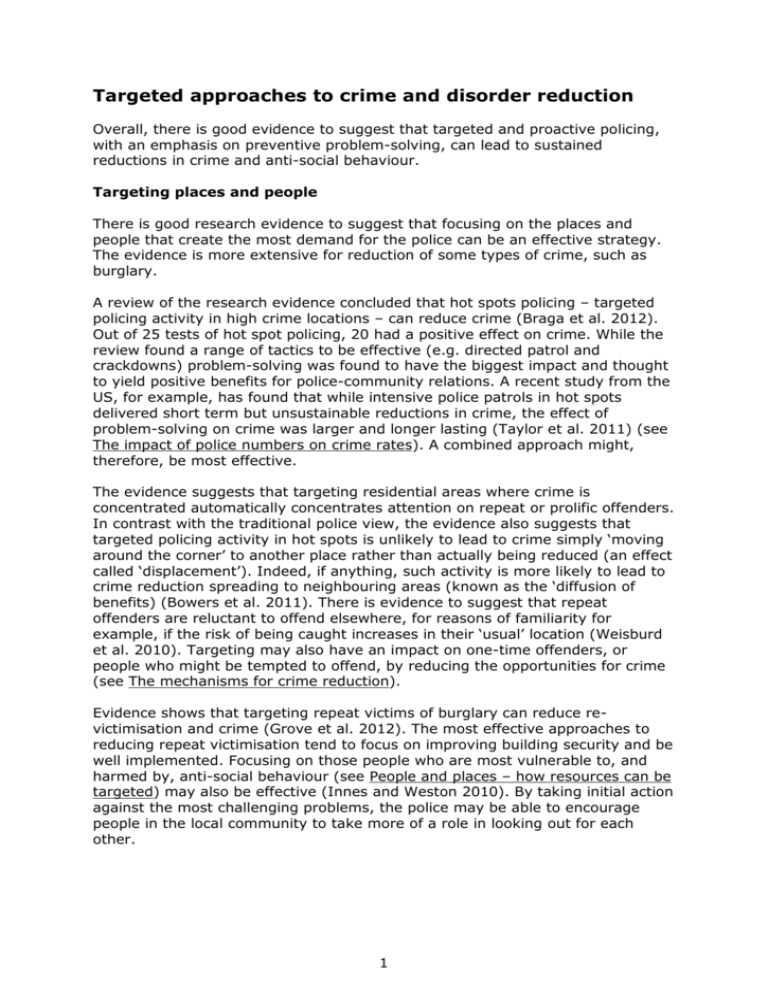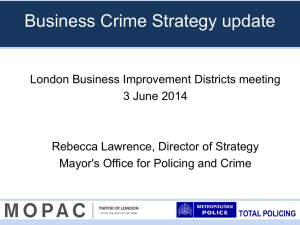Introduction / preface - What Works Centre for Crime Reduction
advertisement

Targeted approaches to crime and disorder reduction Overall, there is good evidence to suggest that targeted and proactive policing, with an emphasis on preventive problem-solving, can lead to sustained reductions in crime and anti-social behaviour. Targeting places and people There is good research evidence to suggest that focusing on the places and people that create the most demand for the police can be an effective strategy. The evidence is more extensive for reduction of some types of crime, such as burglary. A review of the research evidence concluded that hot spots policing – targeted policing activity in high crime locations – can reduce crime (Braga et al. 2012). Out of 25 tests of hot spot policing, 20 had a positive effect on crime. While the review found a range of tactics to be effective (e.g. directed patrol and crackdowns) problem-solving was found to have the biggest impact and thought to yield positive benefits for police-community relations. A recent study from the US, for example, has found that while intensive police patrols in hot spots delivered short term but unsustainable reductions in crime, the effect of problem-solving on crime was larger and longer lasting (Taylor et al. 2011) (see The impact of police numbers on crime rates). A combined approach might, therefore, be most effective. The evidence suggests that targeting residential areas where crime is concentrated automatically concentrates attention on repeat or prolific offenders. In contrast with the traditional police view, the evidence also suggests that targeted policing activity in hot spots is unlikely to lead to crime simply ‘moving around the corner’ to another place rather than actually being reduced (an effect called ‘displacement’). Indeed, if anything, such activity is more likely to lead to crime reduction spreading to neighbouring areas (known as the ‘diffusion of benefits) (Bowers et al. 2011). There is evidence to suggest that repeat offenders are reluctant to offend elsewhere, for reasons of familiarity for example, if the risk of being caught increases in their ‘usual’ location (Weisburd et al. 2010). Targeting may also have an impact on one-time offenders, or people who might be tempted to offend, by reducing the opportunities for crime (see The mechanisms for crime reduction). Evidence shows that targeting repeat victims of burglary can reduce revictimisation and crime (Grove et al. 2012). The most effective approaches to reducing repeat victimisation tend to focus on improving building security and be well implemented. Focusing on those people who are most vulnerable to, and harmed by, anti-social behaviour (see People and places – how resources can be targeted) may also be effective (Innes and Weston 2010). By taking initial action against the most challenging problems, the police may be able to encourage people in the local community to take more of a role in looking out for each other. 1 Problem-solving A review1 of the most robust research studies has shown that problem-solving is an effective overall policing strategy for crime reduction (Weisburd et al. 2008). Of the ten studies included in the review, eight reported significant reductions in crime (including all of those using experimental research designs which is the most robust research methodology). The adoption of a problem-solving approach typically involves the police following the four key stages of the SARA model (Clarke and Eck 2003): Scan – identifying which are most important problems to tackle from a range of issues Analyse – using a range of data to understand the nature of these problems (what, where, when, who) and their likely root causes (why) Respond – implementing tailor-made solutions that seeks to deal with the underlying causes of these problems Assess – evaluating whether the responses have been successful (e.g. using recorded crime, victim surveys, partnership data and/or community engagement) and, if not, repeating the process until effective solutions are in place Problem-solving often requires the police to work in partnership with local people and other organisations (e.g. local authorities, criminal justice agencies, charities) to put in place sustainable solutions to problems (Bullock et al 2006). Engaging local communities in the process can be particularly effective as they can help to identify the crime and anti-social behaviour problems – the ‘signal crimes and disorders’ – which affect people the most (Innes 2004; Tuffin et al. 2006). Partners can play a vital role in problem-solving because the police have limited resources, they do not own all the remedies, and do not have all the information to diagnose the problem. Involving partners in the problem-solving can sometimes be necessary because it can take coordinated action, for example, to reduce violence in a town centre related to late night drinking (e.g. analysing hospital admission data, reviewing licensing decisions, introducing toughened drinking glasses, changing police patrol patterns, and targeting alcohol treatment services) or to tackle gun crime (Braga and Weisburd, 2012) . While problem-solving can be an effective strategy, it has often been poorly implemented in the past which has made crime reduction less likely (Skogan 2006). Problem-solving appears to be most successful when it is focused and when there is a strong organisational commitment to its principles (Read and Tilley 2000; Bullock et al. 2006; Weisburd et al. 2008). Also, there is a tendency for the police to ‘rush to solution’ without fully understanding the problem or thinking systematically about what might help resolve it (Bullock et al. 2006). 1 A systematic review was used: a research method which assesses all available evidence using clear and transparent search terms. It applies pre-determined criteria to sift out those studies of a poor quality or which use designs which fail to control for the influence of factors other than the intervention studied on results. 2 References Bowers, K., Johnson, S., Guerette, R., Summers, L. and Poynton, S. (2011). Do Geographically Focussed Police Initiatives Displace Crime or Diffuse Benefits? A Systematic Review. Journal of Experimental Criminology, 7 (4): 347-374 Braga, A. and Weisburd, D. (2012) The Effects of ‘Pulling Levers’ Focused Deterrence Strategies on Crime. Campbell Collaboration. Braga, A., Papachristos, A. and Hureau, D. (2012) Hot Spots Policing Effects on Crime. Oslo: Campbell Collaboration. Bullock, K., Erol, R. and Tilley, N. (2006) Problem-Oriented Policing and Partnership: Implementation of an Evidence Based Approach to Crime Reduction. Cullompton: Willan. Clarke, R. and Eck J. (2003) Become a Problem Solving Crime Analyst: In 55 Small Steps. London: Jill Dando Institute of Crime Science, UCL. Grove, L., Farrell, G., Farrington, D., and Johnson, S. (2012) Preventing Repeat Victimization: A Systematic Review. Stockholm: The Swedish National Council for Crime Prevention. Innes, M. (2004) Signal Crimes and Signal Disorders: Notes on Deviance as Communicative Action. British Journal of Sociology, 55 (3): 335-55. Read, T. and Tilley, N. (2000) Not Rocket Science? Problem-solving and Crime Reduction. London: Home Office. Skogan, W. (2006) The Promise of Community Policing, in: Weisburd, D. and Braga, A. (eds) Police Innovation: Contrasting Perspectives. Cambridge: Cambridge University Press. Taylor, B., Koper, C., and Woods, D. (2011). A Randomized Controlled Trial of Different Policing Strategies at Hot Spots of Violent Crime. Journal of Experimental Criminology, 7: 149-181. Tuffin, R., Morris, J. and Poole, A. (2006) An Evaluation of the Impact of the National Reassurance Policing Programme. London: Home Office. Weisburd D., Telep, C. Hinkle, J., Eck, J. (2008) The Effects of Problem-Oriented Policing on Crime and Disorder. Oslo: Campbell Collaboration. 3









